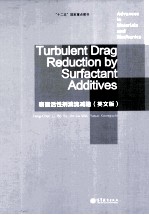

表面活性剂湍流减阻 英语版PDF电子书下载
- 电子书积分:11 积分如何计算积分?
- 作 者:李凤臣等著
- 出 版 社:北京:高等教育出版社
- 出版年份:2012
- ISBN:7040348156
- 页数:257 页
1 Introduction 1
1.1 Background 1
1.2 Suffactant Solution 4
1.2.1 Anionic Suffactant 6
1.2.2 Cationic Surfactant 6
1.2.3 Nonionic Surfactant 7
1.2.4 Amphoteric Surfactant 7
1.2.5 Zwitterionic Surfactant 7
1.3 Mechanism and Theory of Drag Reduction by Surfactant Additives 8
1.3.1 Explanations of the Turbulent DR Mechanism from the Viewpoint of Microstructures 8
1.3.2 Explanations of the Turbulent DR Mechanism from the Viewpoint of the Physics of Turbulence 10
1.4 Application Techniques of Drag Reduction by Suffactant Additives 14
1.4.1 Heat Transfer Reduction of Surfactant Drag-reducing Flow 15
1.4.2 Diameter Effect of Surfactant Drag-reducing Flow 15
1.4.3 Toxic Effect of Catiomc Surfactant Solution 15
1.4.4 Chemical Stability of Surfactant Solution 15
1.4.5 Corrosion of Surfactant Solution 16
References 16
2 Drag Reduction and Heat Transfer Reduction Characteristics of Drag-Reducing Surfactant Solution Flow 19
2.1 Fundamental Concepts of Turbulent Drag Reduction 19
2.2 Characteristics of Drag Reduction by Suffactant Additives and Its Influencing Factors 22
2.2.1 Characteristics of Drag Reduction by Suffactant Additives 23
2.2.2 Influencing Factors of Drag Reduction by Surfactant Additives 27
2.3 The Diameter Effect of Surfactant Drag-reducing Flow and Scale-up Methods 31
2.3.1 The Diameter Effect and Its Influence 31
2.3.2 Scale-up Methods 32
2.3.3 Evaluation of Different Scale-up Methods 43
2.4 Heat Transfer Characteristics of Drag-reducing Surfactant Solution Flow and Its Enhancement Methods 47
2.4.1 Convective Heat Transfer Characteristics of Drag-reducing Surfactant Solution Flow 47
2.4.2 Heat Transfer Enhancement Methods for Drag-reducing Surfactant Solution Flows 50
References 59
3 Turbulence Structures in Drag-Reducing Surfactant Solution Flow 63
3.1 Measurement Techniques for Turbulence Structures in Drag-Reducing Flow 64
3.1.1 Laser Doppler Velocimetry 64
3.1.2 PIV 66
3.2 Statistical Characteristics of Velocity and Temperature Fields in Drag-reducing Flow 68
3.2.1 Distribution of Averaged Quantities 69
3.2.2 Distribution of Fluctuation Intensities 74
3.2.3 Correlation Analyses of Fluctuating Quantities 77
3.2.4 Spectrum Analyses of Fluctuating Quantities 78
3.3 Characteristics of Turbulent Vortex Structures in Drag-reducing Flow 83
3.3.1 Identification Method of Turbulent Vortex by Swirling Strength 84
3.3.2 Distribution Characteristics of Turbulent Vortex in the x-y Plane 85
3.3.3 Distribution Characteristics of Turbulent Vortex in the y-z Plane 87
3.3.4 Distribution Characteristics of Turbulent Vortex in the x-z Plane 90
3.4 Reynolds Shear Stress and Wall-Normal Turbulent Heat Flux 96
References 100
4 Numerical Simulation of Surfactant Drag Reduction 103
4.1 Direct Numerical Simulation of Drag-reducing Flow 104
4.1.1 A Mathematical Model of Drag-reducing Flow 104
4.1.2 The DNS Method of Dragreducing Flow 109
4.2 R ANS of Drag-reducing Flow 111
4.3 Governing Equation and DNS Method of Drag-reducing Flow 114
4.3.1 Governing Equation 114
4.3.2 Numerical Method 117
4.4 DNS Results and Discussion for Drag-reducing Flow and Heat Transfer 122
4.4.1 The Overall Study on Surfactant Drag Reduction and Heat Transfer bv DNS 122
4.4.2 The Rheological Parameter Effect of DNS on Surfactant Drag Reduction 160
4.4.3 DNS with the Bilayer Model of Flows with Newtonian and Non-Newtonian Fluid Coexistence 173
4.5 Conclusion and Future Work 178
References 179
5 Microstructures and Rheological Properties of Surfactant Solution 183
5.1 Microstructures in Surfactant Solution and Its Visualization Methods 183
5.1.1 Microstructures in Surfactant Solution 183
5.1.2 Visualization Methods for Microstructures in Surfactant Solution 187
5.2 Rheology and Measurement Methods of Surfactant Solution 189
5.2.1 Rheological Parameters 190
5.2.2 Measurement Method of Rheological Parameters 194
5.2.3 Rheological Characteristics of Dilute Drag-reducing Surfactant Solution 200
5.3 Factors Affecting the Rheological Characteristics of Surfactant Solution 207
5.3.1 Surfactant Concentration 207
5.3.2 Temperature 208
5.3.3 Type of Surfactant 208
5.4 Characterization of Viscoelasticity of Drag-reducing Surfactant Solution by Using Free Surface Swirling Flow 209
5.5 Molecular and Brownian Dynamics Simulations of Surfactant Solution 216
5.5.1 Brief Introduction of Simulation Methods 216
5.5.2 Brownian Dynamics Simulation bv Using a WK Potential 221
References 231
6 Application Techniques for Drag Reduction by Surfactant Additives 233
6.1 Problems That Need to Be Solved in Engineering Applications 233
6.1.1 Influencing Factors of Drag-reducing Surfactant Additives on the Heat Transfer Performance of Heat Exchangers and Its Counter-measures 234
6.1.2 Influences of Drag-reducing Surfactant Additives on the Environment 235
6.1.3 Scale-up Problem 236
6.2 Separation Techniques for Surfactant Solution 237
6.2.1 Adsorption 238
6.2.2 Ultrafiltration 238
6.2.3 Reverse Osmosis 239
6.3 Drag Reduction Stability of Surfactant Solutions 239
6.3.1 Effect of Adsorption 239
6.3.2 Effects of Fe(OH)3 240
6.3.3 Effects of Cu(OH)2 241
6.3.4 Recovery of Drag Reduction 241
6.4 Applications of Surfactant Drag Reduction 242
6.4.1 Application of Surfactant to Hydronic Heating and Air-Conditioning Systems 242
6.4.2 Surfactant Selection in Actual Applications 251
References 253
Index 255
- 《生物质活性炭催化剂的制备及脱硫应用》宁平,李凯,宋辛著 2019
- 《香豆素衍生物合成与农药活性研究》(中国)郝双红 2019
- 《新型吲哚七甲川菁类近红外荧光探针的设计、合成及生物活性研究》孙春龙著 2019
- 《高比表面积碳化硅》郭向云编著 2019
- 《海洋生物活性物质》迟玉森,张付云著 2017
- 《深度思考 透过表面看本质的六步思考法》萧亮著 2019
- 《电活性功能材料的制备及应用》马旭莉著 2019
- 《抗磨损表面工程技术》(印度)ManishRoy编 2018
- 《表面等离激元及其与激子杂化在表面催化反应中的应用》孙萌涛,王鑫鑫,宗欢著 2019
- 《粉体表面改性 第4版》郑水林,王彩丽,李春全编著 2019
- 《全国高等中医药行业“十三五”创新教材 中医药学概论》翟华强 2019
- 《培智学校义务教育实验教科书教师教学用书 生活适应 二年级 上》人民教育出版社,课程教材研究所,特殊教育课程教材研究中心编著 2019
- 《指向核心素养 北京十一学校名师教学设计 英语 七年级 上 配人教版》周志英总主编 2019
- 《习近平总书记教育重要论述讲义》本书编写组 2020
- 《办好人民满意的教育 全国教育满意度调查报告》(中国)中国教育科学研究院 2019
- 《高等数学试题与详解》西安电子科技大学高等数学教学团队 2019
- 《北京生态环境保护》《北京环境保护丛书》编委会编著 2018
- 《教育学考研应试宝典》徐影主编 2019
- 《语文教育教学实践探索》陈德收 2018
- 《家庭音乐素养教育》刘畅 2018
